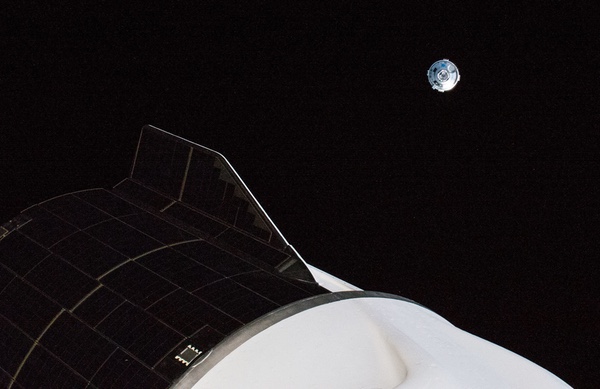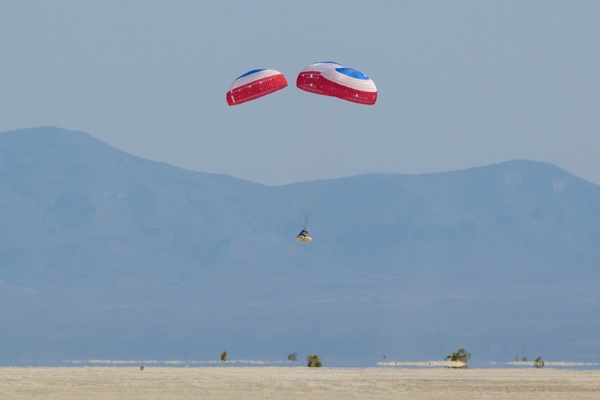Boeing’s commercial crew vehicle is finally (almost) ready for crewby Jeff Foust
|
| “It’s great to have this incredible test flight behind us,” Stich said. “The test flight was extremely successful. We met all the mission objectives.” |
That assessment may have been hyperbolic—Spinal Tap, after all, only went to 11—but it was understandable. Nearly two and a half years after the original OFT mission failed to meet its goals, and more than nine months after the first attempt at launching OFT-2 was cancelled because of corroded valves in the spacecraft’s service module, Starliner had made it to the International Space Station and back, largely successfully.
After docking with the ISS a day after its May 19 launch (see “For Starliner, better late than never”, The Space Review, May 23, 2022), NASA and Boeing wrapped up work on the spacecraft by May 24. That included checking communications and other systems on the spacecraft, while transferring more than 200 kilograms of cargo from the spacecraft to the station and nearly 300 kilograms from the station to the spacecraft for return to Earth.
The final phases of the mission went smoothly, with Starliner undocking from the station at 2:36 pm EDT Wednesday. It moved away from the station, performed a deorbit burn and jettisoned its service module. The spacecraft deployed its drogue and main parachutes as planned, landing at White Sands Space Harbor at 6:49 pm EDT.
Steve Stich, NASA commercial crew program manager, called the landing “picture perfect” at that briefing. The capsule landed within 500 meters of the intended spot, a variance he said was due to winds that were different than what was predicted.
“It’s great to have this incredible test flight behind us,” he said. “The test flight was extremely successful. We met all the mission objectives.”
While successful, the flight wasn’t perfect. Two of 12 Orbital Maneuvering and Attitude Control (OMAC) thrusters, both in the same pod or “doghouse” on the service module, shut down during the orbital insertion burn just after the May 19 launch. Stich said that controllers tested them after undocking but could not recover them. “We saw an interesting signature that looks a little bit like the signatures we saw on shutdown: maybe 25% or so of the thrust that we expected out of those thrusters.”
Nappi said that test can help better understand the root cause of the OMAC thruster failures. “This isolates it more to the thrusters themselves than any other part of the system,” he said.
Stich said that the fact that the thrusters fired showed that commands were reaching the thrusters to open valves and ignite. “We’ll have to look at the legs of the fault tree where we got thrust, but it was not quite the level we expected,” he said.
He said controllers were able to restore two reaction control system thrusters that failed after launch but added one such thruster on the crew capsule may have shut down just before the deployment of the parachutes. That may be easier to investigate than the OMAC thruster failures since that thruster can be inspected, whereas the OMAC thrusters were on the jettisoned service module.
 A SpaceX Crew Dragon spacecraft, docked to the ISS, is in the foreground as Starliner moves away from the station after undocking. (credit: NASA) |
Despite the thruster glitches, both NASA and Boeing sounded optimistic that they would be able to move on to the Crew Flight Test (CFT) mission, where Starliner will carry astronauts for the first time. “I don’t see any reason why we can’t proceed toward the Crew Flight Test next,” Stich said. “I don’t really see any showstoppers this time relative to last time.”
He said OFT-2 compared favorably with Demo-1, the uncrewed test flight of SpaceX’s Crew Dragon in March 2019. “The performance was very similar in lots of ways,” he said, adding that SpaceX had to upgrade its abort thrusters between Demo-1 and the crewed Demo-2 missions, as well as work on parachutes. “I don’t see that here from what we saw on this flight.”
Exactly when CFT will launch, and who will be on board, remains to be seen. Nappi said at the briefing the company is preparing the other Starliner crew capsule, called Spacecraft 3 or Calypso, for CFT. That spacecraft previously flew OFT, while the capsule that returned from OFT-2, called Spacecraft 2, will be prepared for the first operational mission, Starliner-1. (Spacecraft 1 was used for a pad abort test and will not fly in space.)
“We’re off working that right now,” he said. That work will depend on what changes Boeing will need to make to the spacecraft based on lessons from OFT-2. In addition, Boeing will have to negotiate with NASA to find a time when the ISS can accommodate the mission given the schedule of other visiting vehicles. The company will also need an Atlas 5 from United Launch Alliance.
“All that has to come together in order to set a flight date, and we’re probably several months from being able to do that,” he said.
Another issue is who will fly CFT. When NASA made the original crew assignment for the mission in August 2018, agency astronauts Eric Boe and Nicole Mann, along with Boeing commercial astronaut (and retired NASA astronaut) Chris Ferguson were slated to fly. In 2019, Mike Fincke replaced Boe for medical reasons. In 2020, Ferguson announced he would not fly CFT, then expected in 2021, to avoid conflicts with family events. NASA replaced him with astronaut Butch Wilmore.
Last October, NASA reassigned Mann and Josh Cassada, who had been set to go on Starliner-1, to SpaceX’s Crew-5 mission. At a prelaunch briefing for OFT-2 earlier this month, Wilmore, Fincke, and Suni Williams, a NASA astronaut who had also been assigned to Starliner-1, said they were now training together as a “cadre” to fly CFT or Starliner-1. (Jeanette Epps, the NASA astronaut who was bumped from a Soyuz mission to the ISS in 2018 for still-mysterious reasons, remains assigned to Starliner-1 and is not part of that cadre, agency officials later said.)
Wilmore said the OFT-2 postponement in August, along with the reassignments of Mann and Cassada, led to the change. “Since that time in August, the three of us have been working as a cadre supporting Starliner, and we know we are not necessarily assigned to CFT.”
| “It was truly a fantastic test flight, and it puts us in a great position to fly CFT,” said Nappi. |
Kathy Lueders, NASA associate administrator for space operations, said at that prelaunch briefing that crew assignments for CFT would likely come in the summer, after determining the schedule of other missions to the station and how long CFT would last. NASA once envisioned having CFT spend as long as six months at the station, using it as a crew rotation mission when access to Soyuz seats appeared uncertain, but that is no longer necessary as SpaceX’s Crew Dragon is now handling routine crew missions.
“You realize the challenge the crew office has about the assignments and why it’s important to get the right timing and understand when exactly the Crew Flight Test is going to show up,” she said at that briefing. She added there are no plans to have Ferguson or another Boeing commercial astronaut rejoin the CFT mission.
If CFT is needed only as a test flight, the mission would likely last no more than two weeks, and perhaps as little as five to seven days, just enough to confirm the vehicle can safely carry people. Joel Montalbano, NASA ISS program manager, said the station program would make the most of even a limited stay by CFT. “Once we have the mission objectives set for the CFT mission, we’ll make every use of the crew time and add science as required,” he said.
Stich said he felt “ecstatic” about OFT-2, particularly seeing Starliner docked to the ISS at the same time as Crew Dragon. “That’s what the commercial crew program has been about all along, having these two different companies, with the great systems they’ve developed, prove crew transportation to the space station,” he said. “The flight that just landed today demonstrates that the Starliner is a great vehicle for crew transportation.”
“We couldn’t have asked for a better mission,” Nappi said after giving OFT-2 a rating of 15 on a 1-to-10 scale. “It was truly a fantastic test flight, and it puts us in a great position to fly CFT.”
Note: we are using a new commenting system, which may require you to create a new account.
